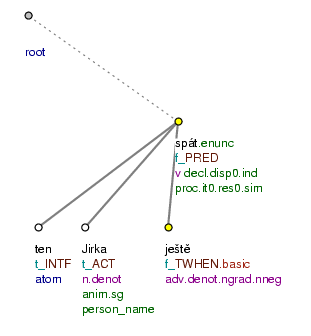- Definition of the
INTFfunctor -
The
INTFfunctor (intensification) is a functor for such an atomic node representing an expression that emphasizes particularly the modification in the subject position and that simultaneously intensifies the entire construction. The position of such an expression is parallel to the subject position (it represents the so-called "false subject").
NB! The INTF functor is also assigned to the modification functioning as an intensifying particle in the "subject" position in subjectless sentences (e.g. Ono.INTF prší. (=lit. It rains.)).
INTF modifications are represented as dependent on the verb, i.e. it depends on the same predicate as the subject and it forms a parallel to the subject.
Forms. The basic form of the INTF modification is usually the personal pronoun on (=he) or the demonstrative pronoun to (=that). These pronouns are always in their nominative form.
Examples:
To.INTF Jirka ještě spí. (=lit. EMPH Jirka still is_asleep.) Fig. 7.43
On.INTF Jirka ještě spí. (=lit. Well, Jirka still is_asleep.)
To.INTF Karel nepřišel. (=lit. That Karel did not come.)
Ono.INTF táhne. (=lit. There is_(a)_draught.)
To.INTF hučí letadla. (=lit. That are_buzzing (the) planes.)
Víš, on.INTF je náš Baryk docela hodnej. (=lit. (You) know EMPH is our Baryk quite good.)
Je to.INTF ostuda, když v poslední zatáčce vyrazí.ACT jako torpédo. (=lit. Is it (a) shame that in (the) last curve (he) darts like (a) torpedo.)
Více lidí do práce - to .INTF je klíčové slovo pro úspěšné řešení sociálních otázek. (=lit. More people to work - that is (the) key word to (a) successful solution (of) social questions.)
Border with the RSTR functor. Modifications with the INTF functor are marginal. If they are expressed by the demonstrative pronoun to (=that), they can get close to the demonstrative pronouns in the position of a modification with the RSTR functor (see Section 10.5, "RSTR"). However, they are different from them because they lack the gender and number agreement with the emphasized noun. Cf.:
-
To.
INTFKarel nepřišel. (=lit. It_is_that.neut Karel did not come.) -
Ten.
RSTRKarel nepřišel. (=lit. That.masc Karel did not come.)
INTF modifications also do not have to be adjacent to the subject they emphasize (unlike the pronouns in the RSTR position) . Cf.:
-
To.
INTFhučí letadla. (=lit.That are_ buzzing (the) planes .) -
Ta.
RSTRletadla hučí. (=lit. The planes are_buzzing.)
Border with arguments. In subjectless sentences it is necessary to represent the pronouns ten (=that) and on (=he) - on the basis of the valency properties of the governing verb - as modifications with the INTF meaning and not as subjects. Cf.:
-
To.
INTFhučí v komíně. (=lit. That is_ droning (something) in (the) chimney.)Valency frame:
LOC(*) -
Komín.
ACThučí. (=lit. (The) chimney is_droning.)Valency frame:
ACT(.1)
